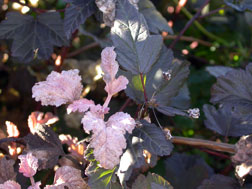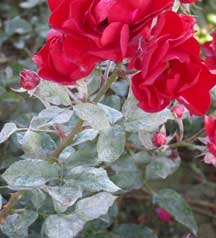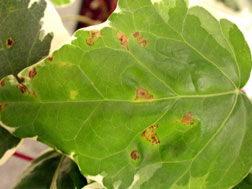Exploring alternatives for disease control on trees and shrubs
Editor’s note: This article is from the archives of the MSU Crop Advisory Team Alerts. Check the label of any pesticide referenced to ensure your use is included.
Keeping an eye out for information on less toxic strategies to control pest problems has increased value now due to public pressure for more safe pesticides to be used in the landscape environment. Recently, I ran across this article in an edition of the Branching Out newsletter from Cornell University. I personally know the author and respect the research she does for the ornamentals industry. I hope you find it to be of value to your business. This article is reprinted with permission from Branching Out, An IPM Newsletter for Trees and Shrubs, Vol 15, No.3 - Tom Dudek, MSUE educator.
Alternative to what?
Alternative products are very much the rage today, as the chemophobic public wants reassurance that their landscape maintenance is not poisoning their living environment. Primarily, this has meant an industry-wide shift away from organophosphate chemistries that have high mammalian toxicity. Organophosphates have been widely used as insecticides for the past few generations. During this same time period, fungicides have been made from chemical classes that are inherently less toxic to humans. However, with some of the older fungicides, the potential for negative effects other than acute toxicity has caused concern. In recent years, certain fungicide materials have been banned under laws in trendsetting places like New York City and California. The New York City Local Law 37, enacted May, 2005, excludes from use on City property any pesticides that EPA lists as Toxicity Category I (Danger label), or as known, probable, likely or possible carcinogens, or that the state of California has classified as developmental toxins.
Given the public demand for chemicals without strong potential for negative health or environmental effects, the federal government has recently been favoring the registration of softer materials, and the marketplace is embracing them. This article will cover some of the alternatives to the previously popular fungicides that have now been identified as potentially harmful to people or the environment.
Strobilurin fungicides
The strobilurin fungicides are a group of newer materials that are quite valuable for their broad-spectrum and effective disease management contributions. They are all at least somewhat systemic, and are thus powerful but relatively at-risk for the development of resistance in pathogens. Fungicide resistance is most likely to develop in powdery mildews, downy mildews and Botrytis. Thus labels specify how many times per season a strobilurin fungicide may be used, and it is important to recognize which fungicides are in this group so that you do not mistakenly rotate from one to another: they all have the same mode of action. Compass (trifloxystrobin) is a strobilurin for which all uses are considered reduced-risk by EPA. It has broad usefulness as an ornamentals fungicide, providing excellent control of many leaf spot diseases including anthracnoses, as well as rusts, downy mildews and powdery mildews. Azoxystrobin and pyraclostrobin, the active ingredients in Heritage and Insignia, respectively, are the other widely-used and similarly-effective strobilurin fungicides. These materials should be used wisely, in order to maintain their usefulness in landscape maintenance for a long time to come.

Powdery mildew on ninebark.

Powdery mildew on rose leaves.
Phos acids
Another category of “safer” systemic materials are the phosphorous acids or phosphonates. The first of these was Aliette, fosetyl-Al, which was introduced decades ago. Now a large number of products including Avalon, Flanker, Phostrol, Alude, Fungi-Phite T&O, and K-Phite have been labeled in New York with the same mode of action as Aliette. These vary in their acidity, and in whether there is aluminum included in the formulation, but they all have similar modes of action. The phos acid materials offer some key uses: downy mildew control on roses, Pythium and Phytophthora management, as well as some suppression against certain bacterial diseases. Aluminum toxicity has been problematic with application of Aliette on some plants, such as azaleas. Precautions given on some of the phos acid labels indicate that they should not be applied to heat-stressed or drought-stressed plants, or within 14-20 days of a copper application. These materials should not be applied if the foliage will not dry promptly. Some of the phos acid products are not safe to tank-mix with spreader-stickers, or with flowable chlorothalonil or mancozeb products, so be careful to read the label of the particular material you are using.
The phos acid materials may be used on ornamental and bedding plants in landscape, nursery and greenhouse. The ability of these materials to limit Phytophthora disease is unquestioned—this is their strongest suit. Results on other kinds of diseases will be variable. The leaf spot on English ivy caused by Xanthomonas campestris pv. Hederae is one of the bacterial diseases for which phos acids are labeled. Fire blight suppression is also listed for some ornamentals.

Leaf spot on English ivy caused by
Xanthomonas campestris pv. Hederae.
Mefenoxam
Mefenoxam, known to us in the product SubdueMAXX, has all of its uses considered “reduced-risk” by EPA. SubdueMAXX is a systemic chemical widely used in the nursery trade as a weapon against Phytophthora and Pythium species during production. This same material may be used in the landscape, as well, primarily to inhibit Phytophthora. This is a long-lasting, effective fungicide when it is used against mefenoxam-sensitive strains of Pythium or Phytophthora—if resistant strains are encountered, use a phos acid fungicide instead. As a resistance management strategy, a long-term fungicide management program should employ both phos acids and mefenoxam in alternation.
Bicarbonates
Potassium bicarbonate, sold as Armicarb, Milstop and Kaligreen, etc. has been used effectively in powdery mildew control programs for years. Some of the product labels containing potassium bicarbonate allow for use on other diseases as well, and it will take some experimentation to learn which other diseases respond to treatment with this active ingredient. This is a contact action material that generally should be used in alternation with other chemical or biological products for best results. If phytotoxicity develops, usually seen as a marginal leaf scorch, use a lower rate or alternate with another material to increase the interval between applications.
Biologicals
Biological fungicides tend to have negligible toxicity to humans, and no history of carcinogenic or developmental effects on test animals. Data on the effectiveness of the biologicals in landscape use is often limited, but the labels are helpfully broad, encouraging product use for suppression of many different pathogens. Some of the pathogens named on the label may have been suppressed in laboratory plate tests rather than in field trials; time will tell whether they are also effectively treated for under the less controlled conditions in the outdoor environment. Rather than thinking of biofungicides as cures for diseases, think of them as biological tools for treating plants preventively, decreasing the odds that a pathogen will successfully attack to cause disease. Biological controls are thus used as health insurance, not in response to the appearance of disease symptoms. They are very compatible with overall integrated pest management (IPM) philosophy—but one should not wait for a disease threshold to be reached before deploying a biofungicide. In many instances, the best use of a biological may be occasional treatments in alternation with reduced-risk chemicals.
One of the best known of the biologicals for disease control is Rhapsody AS, which contains Bacillus subtilis strain QST 713, a bacterium. This protectant material is even approved by OMRI for use in organic production, as well as for use in a broad range of sites including landscapes and golf courses, plus sod and ornamental production. Using a surfactant to improve coverage is recommended, and the higher labeled rates may be needed under significant disease pressure. Rhapsody may be applied as a spray or as a drench. As a spray, its forté is powdery mildew, but a measurable benefit from Rhapsody has also been seen against some bacterial leaf spots, Cercospora leaf spot, Botrytis blight and downy mildew. Only copper treatments offer similar versatility, with effectiveness against bacteria as well as fungi. As a soil drench, the Rhapsody label offers suppression of Fusarium, Pythium, Phytophthora and Rhizoctonia.
Actinovate SP, a biofungicide labeled for production and landscape use, has Streptomyces lydicus WYEC 108, an actinomycete, as its active ingredient. Drenches and foliar sprays may be made in the landscape as new plants are being transplanted, or to established plants. Treatments are of benefit only when made preventively. Actinovate’s original use was for soilborne diseases—the label lists problems caused by Pythium, Rhizoctonia, Phytophthora, Verticillium and Fusarium. Some suppression of powdery mildew, downy mildew, Botrytis, Alternaria, and Sclerotinia is also claimed for foliar applications. Studies on ornamental crops have thus far shown powdery mildew and Botrytis to be measurably reduced by Actinovate treatment. The Actinovate AG label, which relates to agricultural uses, includes a mention of Monilinia control, which suggests that the Actinovate SP may help to keep ornamental cherries free from brown rot. This biocontrol is effective at temperatures above 45ºF. A non-ionic spreader-sticker such as Latron B1956 should be added for the best results. For landscape use, treatment can be at transplant or to established plants. Ornamental bulbs may also be dusted or soaked in a suspension of Actinovate SP prior to planting, or drenched subsequently. The material may also be used for pre-plant treatment of bare-root trees.
Using alternatives
Whether you are employing strobilurins, phos acids, mefenoxam, bicarbonates or biologicals in your business, use of these materials and others with lower human and environmental risk is forward-thinking and commendable. Stay informed regarding research on the effectiveness of new materials you are not familiar with, and conduct small-scale tests yourself whenever opportunities present themselves. Remember that a test should include a non-treated control—a luxury not always available in the landscapes in which you are striving to maintain ornamental quality.



 Print
Print Email
Email

